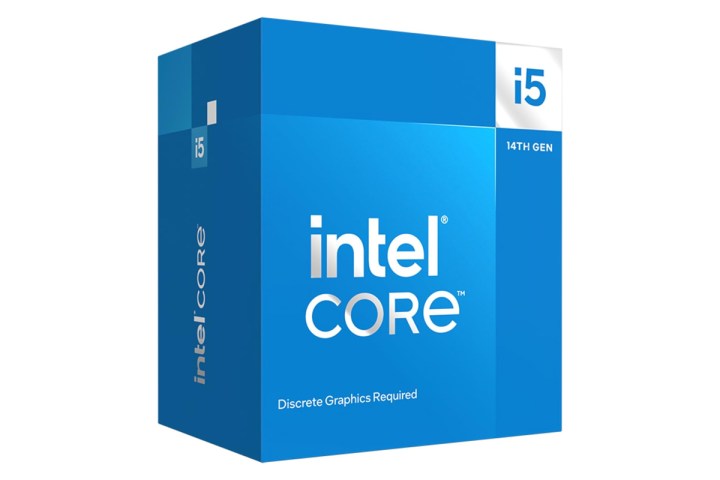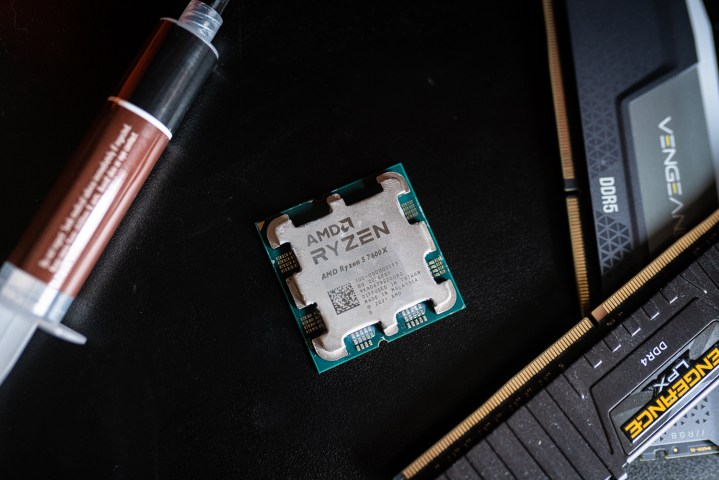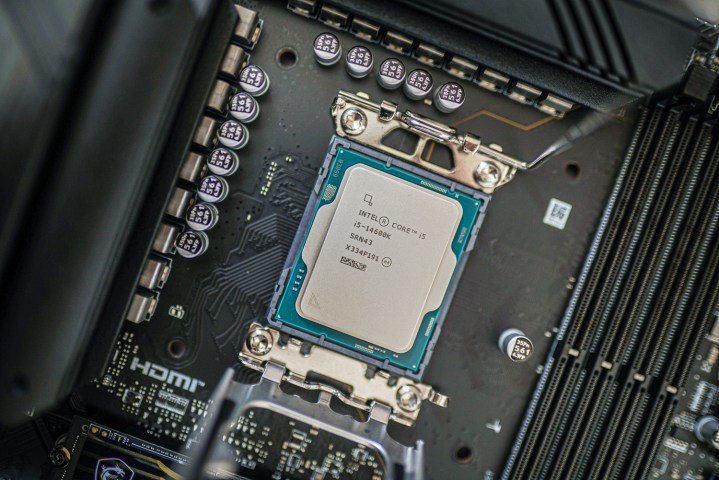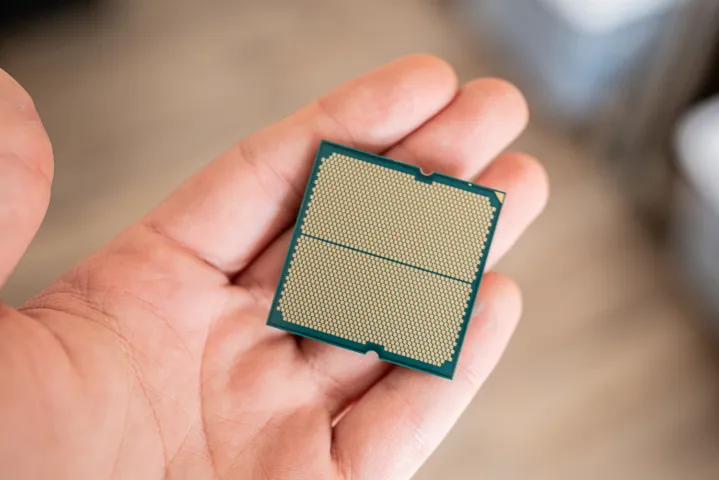Ryzen 5 7600 vs. Core i5-14400: two of the best budget CPUs
If you’re buying or building a new computer in 2024, your two main CPU choices are AMD’s Ryzen 7000 series or Intel’s 13th and 14th generations. Two of the best budget CPUs from those two lines are the AMD Ryzen 5 7600 and Intel’s Core i5-14400. Both are built on the latest processes and architectures from each company, and come with plenty of cores and high clock speeds. They’re also far more power efficient than the top chips.
To help you decide which is the best CPU for you, let’s take a look at how the 7600 and 14400.
Pricing and availability
The AMD Ryzen 7600 was initially launched in January 2023 alongside the other non-X CPUs from its generation. It debuted with a price tag of $229, which it has mostly maintained to this day. However, the higher-end 7600X has come down in price and can often be found for a comparable investment, so it’s always worth checking that price before buying a 7600.

The Intel Core i5-14400 launched in January 2024, alongside the other non-K variants of the 14th generation with a recommended retail price of $221. Most retailers at the time of writing have it listed at $270, though many are discounting it to $240. The 14400F is available at a slight discount — typically closer to $210 — but it doesn’t have onboard graphics.
Both the 7600 and 14400 are widely available at a range of retailers.
Specs
| AMD Ryzen 5 7600 | Intel Core i5-14400 | |
| Cores/threads | 6/12 | 6P+4E/16 |
| Base clock | 3.8GHz | 2.5GHz |
| Boost clock | 5.1GHz | 5GHz |
| L2+L3 cache | 38MB | 29.5MB |
| TDP | 65W | 65W/148W |
| Price | $230 | $240 |
Since these chips are from two different manufacturers with different design ideas, their specs are quite distinct. The Ryzen 7600 uses a traditional single-core architecture, Zen 4, for all six of its cores, with 12-thread support thanks to simultaneous multithreading. The Intel CPU, on the other hand, has six performance cores, with an additional four efficiency cores, giving it a total of 10, plus a thread support of 16. That may give it a leg up in some multi-threaded scenarios, but is unlikely to have much impact in gaming, where the E cores are rarely utilized.
Clock speeds are pretty comparable at boost, but it’s notable that the Intel CPU’s base clock is far lower. Cache is higher on the AMD CPU, while maintaining a significantly lower TDP. That AMD CPU will use more power than that when boosting, but it is unlikely to break 90 watts.
Performance
The performance numbers for Intel’s Core i5 14400 are quite limited at the time of writing, as it’s a relatively new chip and not one of the iconic K-series CPUs that draw all the limelight that comes with a new generation of Intel CPUs. Still, we do have some tentative results, and though they’re not exactly bad, they aren’t that impressive, either.
HWCooling found it put up Cinebench R23 single- and multi-threaded scores of 1,772 and 15,848, respectively. The Ryzen 5 7600 managed 1,833 and 14,639, respectively. That’s about what we’d expect the disparity to be, considering the additional cores in the 14400 giving it a leg up in multi-threading. The 14400 was around 10% faster in productivity applications like Blender, but in all cases was only a few percent better than the last-generation 13400.

In gaming, however, the 7600 really seems to storm ahead. In Counter-strike: Global Offensive it managed over 653 frames per second (fps) in HWCooling’s testing, where the 14400 managed just 442 fps. That’s also actually less than the 13400 managed, with 446 fps. In a more demanding, modern game like Total War Saga: Troy, the, Core i5 14400 managed a 199 fps average at 1080p, where the 7600 achieved a more-impressive 229 fps
We’ll add more results here from a wider array of sources when we have them, but it seems fair to say that in heavy multi-threaded workloads, the 14400 has an advantage, but in single-threaded and gaming scenarios, the Ryzen 5 7600 holds a slight lead, and even the last-generation 13400 is relatively competitive with its newer counterpart.
How’s the upgrade path?
Whenever you buy a new processor or build a new PC, it’s always important to consider what you might upgrade it with in the future. That’s not to say you should always be looking to the next thing, but upgradability is a factor in any PC build, so making sure yours has somewhere to go without needing a huge overhaul is a wise move.
In the case of the Ryzen 5 7600, the world is your oyster. With this CPU, you’re sitting at the basement of a new socket generation (AM5), which AMD has pledged to support for several more generations from now. That means not only do you have the entire Ryzen 7000 range to upgrade to — including the excellent 7800X3D gaming CPU — but anything from the next few generations that comes along. You probably won’t even have to upgrade your motherboard beyond a BIOS update, and your DDR5 memory should be good for years to come.

The Core i5-14400 is a different story. Intel is switching to a new socket design for its 15th generation, so you can only upgrade this chip to higher-end 14000-series processor. While the 14600K and higher-end models will give a big bump in performance, they are not very efficient and will quickly fall behind future generations of CPUs from either camp. Zen 5 and Arrow Lake are already looking very impressive.
If you buy the 14400, plan to grab a 14600K at some point in the future, but the higher-end options are a hard sell unless you get them at a steep discount.
14400 vs 7600: Which CPU is the best?
The Core i5-14400 might be the best Intel CPU of its generation in terms of its bang-for-the-buck performance, but when it’s sitting alongside power-hungry hogs like the 14900K and 14700K, that’s not saying much. It still draws way too much power, isn’t that much better than the last-generation 13400, and has very little in the way of upgrade prospects.
It is the faster CPU in terms of productivity, though, so if you plan to work and play with your PC, then a Core i5 14400 might be worth your while. However, everywhere else,the Ryzen 5 7600 holds a real advantage. It’s comparably priced, offers competitive performance in multi-threaded workloads, and storms ahead in most games, with a significant lead in frame rate — which at this price is even more important.
It’s also more power efficient, and has all the upgrade potential in the world. If you’re looking to play games with your new PC, it’s the better CPU — especially since you can buy the Ryzen 5 7600X for a similar cost, and that chip is a little bit quicker, as our testing showed.
Editors’ Recommendations

If you’re buying or building a new computer in 2024, your two main CPU choices are AMD’s Ryzen 7000 series or Intel’s 13th and 14th generations. Two of the best budget CPUs from those two lines are the AMD Ryzen 5 7600 and Intel’s Core i5-14400. Both are built on the latest processes and architectures from each company, and come with plenty of cores and high clock speeds. They’re also far more power efficient than the top chips.
To help you decide which is the best CPU for you, let’s take a look at how the 7600 and 14400.
Pricing and availability
The AMD Ryzen 7600 was initially launched in January 2023 alongside the other non-X CPUs from its generation. It debuted with a price tag of $229, which it has mostly maintained to this day. However, the higher-end 7600X has come down in price and can often be found for a comparable investment, so it’s always worth checking that price before buying a 7600.

The Intel Core i5-14400 launched in January 2024, alongside the other non-K variants of the 14th generation with a recommended retail price of $221. Most retailers at the time of writing have it listed at $270, though many are discounting it to $240. The 14400F is available at a slight discount — typically closer to $210 — but it doesn’t have onboard graphics.
Both the 7600 and 14400 are widely available at a range of retailers.
Specs
| AMD Ryzen 5 7600 | Intel Core i5-14400 | |
| Cores/threads | 6/12 | 6P+4E/16 |
| Base clock | 3.8GHz | 2.5GHz |
| Boost clock | 5.1GHz | 5GHz |
| L2+L3 cache | 38MB | 29.5MB |
| TDP | 65W | 65W/148W |
| Price | $230 | $240 |
Since these chips are from two different manufacturers with different design ideas, their specs are quite distinct. The Ryzen 7600 uses a traditional single-core architecture, Zen 4, for all six of its cores, with 12-thread support thanks to simultaneous multithreading. The Intel CPU, on the other hand, has six performance cores, with an additional four efficiency cores, giving it a total of 10, plus a thread support of 16. That may give it a leg up in some multi-threaded scenarios, but is unlikely to have much impact in gaming, where the E cores are rarely utilized.
Clock speeds are pretty comparable at boost, but it’s notable that the Intel CPU’s base clock is far lower. Cache is higher on the AMD CPU, while maintaining a significantly lower TDP. That AMD CPU will use more power than that when boosting, but it is unlikely to break 90 watts.
Performance
The performance numbers for Intel’s Core i5 14400 are quite limited at the time of writing, as it’s a relatively new chip and not one of the iconic K-series CPUs that draw all the limelight that comes with a new generation of Intel CPUs. Still, we do have some tentative results, and though they’re not exactly bad, they aren’t that impressive, either.
HWCooling found it put up Cinebench R23 single- and multi-threaded scores of 1,772 and 15,848, respectively. The Ryzen 5 7600 managed 1,833 and 14,639, respectively. That’s about what we’d expect the disparity to be, considering the additional cores in the 14400 giving it a leg up in multi-threading. The 14400 was around 10% faster in productivity applications like Blender, but in all cases was only a few percent better than the last-generation 13400.

In gaming, however, the 7600 really seems to storm ahead. In Counter-strike: Global Offensive it managed over 653 frames per second (fps) in HWCooling’s testing, where the 14400 managed just 442 fps. That’s also actually less than the 13400 managed, with 446 fps. In a more demanding, modern game like Total War Saga: Troy, the, Core i5 14400 managed a 199 fps average at 1080p, where the 7600 achieved a more-impressive 229 fps
We’ll add more results here from a wider array of sources when we have them, but it seems fair to say that in heavy multi-threaded workloads, the 14400 has an advantage, but in single-threaded and gaming scenarios, the Ryzen 5 7600 holds a slight lead, and even the last-generation 13400 is relatively competitive with its newer counterpart.
How’s the upgrade path?
Whenever you buy a new processor or build a new PC, it’s always important to consider what you might upgrade it with in the future. That’s not to say you should always be looking to the next thing, but upgradability is a factor in any PC build, so making sure yours has somewhere to go without needing a huge overhaul is a wise move.
In the case of the Ryzen 5 7600, the world is your oyster. With this CPU, you’re sitting at the basement of a new socket generation (AM5), which AMD has pledged to support for several more generations from now. That means not only do you have the entire Ryzen 7000 range to upgrade to — including the excellent 7800X3D gaming CPU — but anything from the next few generations that comes along. You probably won’t even have to upgrade your motherboard beyond a BIOS update, and your DDR5 memory should be good for years to come.

The Core i5-14400 is a different story. Intel is switching to a new socket design for its 15th generation, so you can only upgrade this chip to higher-end 14000-series processor. While the 14600K and higher-end models will give a big bump in performance, they are not very efficient and will quickly fall behind future generations of CPUs from either camp. Zen 5 and Arrow Lake are already looking very impressive.
If you buy the 14400, plan to grab a 14600K at some point in the future, but the higher-end options are a hard sell unless you get them at a steep discount.
14400 vs 7600: Which CPU is the best?
The Core i5-14400 might be the best Intel CPU of its generation in terms of its bang-for-the-buck performance, but when it’s sitting alongside power-hungry hogs like the 14900K and 14700K, that’s not saying much. It still draws way too much power, isn’t that much better than the last-generation 13400, and has very little in the way of upgrade prospects.
It is the faster CPU in terms of productivity, though, so if you plan to work and play with your PC, then a Core i5 14400 might be worth your while. However, everywhere else,the Ryzen 5 7600 holds a real advantage. It’s comparably priced, offers competitive performance in multi-threaded workloads, and storms ahead in most games, with a significant lead in frame rate — which at this price is even more important.
It’s also more power efficient, and has all the upgrade potential in the world. If you’re looking to play games with your new PC, it’s the better CPU — especially since you can buy the Ryzen 5 7600X for a similar cost, and that chip is a little bit quicker, as our testing showed.
Editors’ Recommendations
